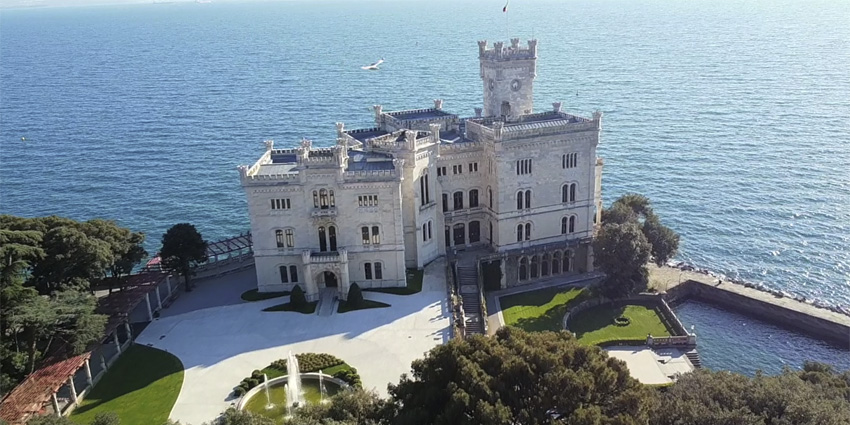
Miramare Castle: Between Imperial History and Timeless Beauty
Among the wonders of Friuli Venezia Giulia, Miramare Castle stands out for its historical, artistic, and natural value.
Located on a promontory overlooking the Gulf of Trieste, just a few kilometers from the city center, this castle is not only a must-see destination for visitors but also a true symbol of Trieste, steeped in Central European charm.
Anyone visiting Trieste should consider including Miramare Castle in their itinerary: its white silhouette against the blue of the sea is like a fairy tale vision. A morning visit is ideal, when the sunlight enhances the brightness of the stone and the landscape remains quiet and serene, offering an authentic contemplative experience.
The Origins: The Dream of Archduke Ferdinand Maximilian
Miramare Castle was built between 1856 and 1860 at the request of Archduke Ferdinand Maximilian of Austria, the younger brother of Emperor Franz Joseph I. Captivated by Trieste’s mild climate and seascape, Maximilian chose this location for his private residence, which was meant to reflect his ideals of beauty, harmony, and culture. He lived here with his wife, Charlotte of Belgium, during what were some of the most peaceful years of his life.
In 1864, Maximilian accepted the offer to become Emperor of Mexico—a decision that tragically changed his destiny. After only a few years, political and military turmoil led to his capture and eventual execution in 1867. What began as a place of dreams and ambition soon became a symbol of the transience of power and imperial illusions.
The Castle and the Habsburg Court
In the following years, Miramare Castle welcomed several members of the imperial family. Among the most notable guests were Emperor Franz Joseph I and his wife, Empress Elisabeth of Bavaria, famously known as Sissi, who spent several days in the elegant residence. Their stay is documented and reflected in some of the castle’s rooms, which still retain traces of imperial life.
The bond between the Habsburg dynasty and this site is deep and enduring. The castle was more than a summer residence—it was a private refuge where the Austro-Hungarian nobility could escape from the pressures of court life in Vienna. The proximity to the sea, the wide horizon, the lush plant life, and the mild climate made Miramare an ideal place for reflection and rest.
Architecture and Interiors: A Balance of Elegance and Function
The architectural project was entrusted to Carl Junker, an engineer who designed the building in a 19th-century eclectic style, blending neo-Gothic, neo-Renaissance, and neoclassical elements. The castle spans multiple levels, with white stone facades and turrets reminiscent of medieval fortresses.
The interiors are sumptuous yet never excessive. Each room is furnished with original 19th-century furniture, fine wooden paneling, rich fabrics, and personal belongings of Maximilian and Charlotte. Every space tells a story: the private study, the music room, the bedchambers, and the throne room are tangible testimonies to a noble lifestyle suspended between beauty and destiny.
The Botanical Park: A Garden Between Sky and Sea
One of the most captivating features of Miramare Castle is its vast botanical park, stretching over 22 hectares around the residence. Designed by Maximilian as an exotic garden, the park features a wide variety of plant species from all over the world: Lebanese cedars, American sequoias, palm trees, maritime pines, and tropical plants blend harmoniously with native Mediterranean flora.
The landscaping was carefully planned in a Romantic style, with winding paths, shaded trails, small belvederes, and ornamental ponds. Walking through Miramare’s park is like entering an enchanted landscape where nature becomes art and leads visitors on a unique emotional journey.
A Museum of History, Nature, and Culture
Today, Miramare Castle is a national historical museum, welcoming thousands of visitors each year. In addition to the residential quarters, the museum hosts temporary exhibitions, photo archives, art shows, and cultural events, further enriching the visitor experience. The layout allows for an immersive journey through 19th-century history, with a focus on Maximilian’s life and the geopolitical landscape of the time.
The museum also promotes scientific research and the conservation of botanical heritage, collaborating with universities and research centers to ensure sustainable management of the site.
A Symbol of Trieste
The silhouette of Miramare Castle, suspended between sky and sea, has become a true icon of Trieste. Its image is often associated with the city’s identity, which for centuries has embodied a fusion of Italian, Austrian, Slovenian, and Central European cultures. The castle is a perfect representation of this blend: a place that tells a story, expresses beauty, and invites reflection.
Those who visit Miramare rarely forget it. The sight of its towers reflected in the sea, the silence of the park, the elegance of its historic interiors, and the tales of extraordinary lives lend the castle an air of noble melancholy that makes it one of the most evocative places in Italy.




